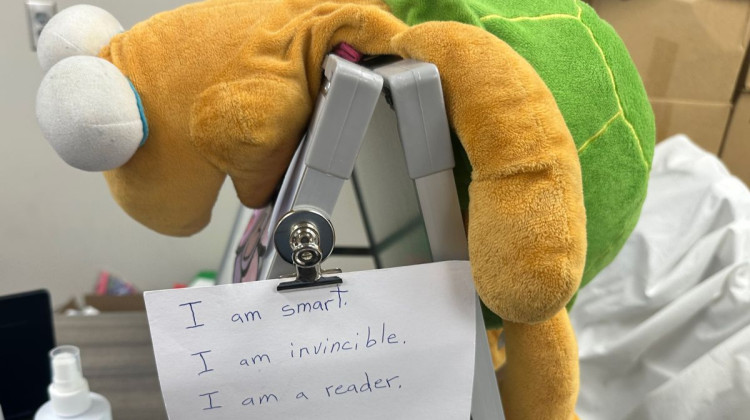The passing rate on Indiana’s third grade reading exam rebounded this year to the highest it's been since before the pandemic. The 5 percentage point jump comes in the same year that a new state law tightens a requirement for schools to hold back students who have not passed the exam.
Just over 87% of third graders passed IREAD, according to results released Wednesday at an Indiana State Board of Education meeting. The gains suggest that the state’s recent focus on elementary literacy skills, including the new retention law and greater investment in training teachers, is beginning to bear fruit.
“The number of Indiana students learning to read is growing at an unprecedented pace and is yet another example of how we are leading the nation in education,” Governor Mike Braun said in a statement.
Last school year, 73,500 students in third grade passed the exam, which aims to test reading skills. The statewide passing rate reached 87.3%, a 4.8 percentage point increase compared to 2023-24.
Indiana has been struggling to improve reading scores for years. Passing rates have gradually declined since the reading exam was introduced in 2012-13, and scores dropped precipitously during the pandemic.
Passing rates have inched up in recent years. But the latest increase is far more notable — the largest the state has seen in the history of the exam — and Indiana leaders touted it as the result of sustained focus on improving reading instruction.
Passing the IREAD assessment is a key indicator of a student's readiness to learn through reading starting in the fourth grade. Without a strong foundation in phonics and phonemic awareness, elementary students may struggle to decode words, leading to difficulties in reading fluently and accurately.
“Indiana has made extraordinary progress from where we began just a few years ago,” Indiana Secretary of Education Katie Jenner said in a statement. “The data is clear – what we are doing is working – so let’s keep at it, ensuring a brighter future for Hoosier students.”
All student groups made gains. Passing rates increased by more than 7 percentage points among Black students, Hispanic students, students receiving special education and students learning English. The passing rate jumped by over 6 percentage points for students receiving free or reduced-price lunch.
Officials also set a goal for 95% of third graders to pass IREAD by 2027. More than 450 schools reached the goal during the 2024-25 school year.
Starting this year, second graders take the assessment to check if they are on track to pass. Those who pass in second grade, don’t take the test again.
Holding students back
Students who were in third grade in 2024-25 were the first class to face new, stricter grade-retention rules. In order to move on to fourth grade, they either needed to pass the state reading test or qualify for an exemption. Indiana had a prior retention law, but it was not strictly enforced and many students were moved up to fourth grade without passing the test.
Far more students are expected to be retained in third grade under the new law. But the state did not release retention data Wednesday.
The new law was a wake up call for Principal Tami Clouse of Central Catholic School. In the elementary school on the south side of Indianapolis, the majority of students are English language learners. And she said in the past, many had moved up to fourth grade without passing IREAD.
“In my mind, I’m calculating ‘how many kids can I fit in a classroom? Who’s going to teach these students and where am I going to find these teachers?’” Clouse said.
Last year, her school responded by joining the Indiana Literacy Cadre, a state program that provides training in reading instruction to educators. Educators used data to identify students who needed help, worked with those students in small groups and put increased focus on parent involvement — including with Spanish speaking parents, Clouse said.
“Reading is reading no matter what the language is,” Clouse said.
That work paid off. Passing rates at the school more than doubled and over 95% of third graders passed the exam last school year.
Clouse was among several school leaders who spoke to the board about how they oversaw a large increase in proficiency.
“Hearing from all of the folks in the room, the level of almost like competitive energy we have to get this done for kids, and that has just driven us,” Jenner said. “Everyone’s got to be all in. It has to be everybody’s hand in, and we all can be a part of the solution.”
‘Cut the fluff’
Indiana has also focused on improving reading instruction. A recent law requires K-12 reading curriculum and teacher training at state colleges to follow evidence-based practices that are often known as the science of reading. Those emphasize phonemic awareness, phonics, vocabulary, fluency and comprehension.
The Indiana Department of Education pointed to the Indiana Literacy Cadre as a model of how it's helping schools improve reading instruction. More than 550 schools are participating this academic year, up from 41 schools when it started in 2022.
On average, Literacy Cadre schools saw a 7 percentage point increase in IREAD passing rates this year, compared to gains of 3.6 percent points at schools that were not part of the program.
India Williams, a Literacy Cadre coach with the Evansville Vanderburgh School Corporation, attributed substantial gains in the district passing rate to educators’ focus on research-based methods.
“We explicitly taught the research-based stuff and cut the fluff,” said Williams, a paraphrase she attributed to literacy consultant Anita Archer.
Local communities have also focused on improving reading. In Marion County, the city used federal pandemic aid to launch Circle City Readers, a program that provides tutoring for vulnerable students.
Contact WFYI education reporter Dylan Peers McCoy at dmccoy@wfyi.org.
 DONATE
DONATE







 Support WFYI. We can't do it without you.
Support WFYI. We can't do it without you.